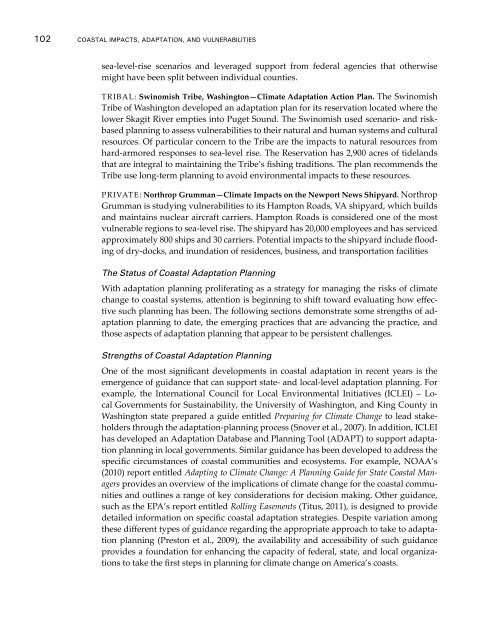Coastal Impacts, Adaptation, and Vulnerabilities - Climate ...
Coastal Impacts, Adaptation, and Vulnerabilities - Climate ...
Coastal Impacts, Adaptation, and Vulnerabilities - Climate ...
Create successful ePaper yourself
Turn your PDF publications into a flip-book with our unique Google optimized e-Paper software.
102 <strong>Coastal</strong> <strong>Impacts</strong>, <strong>Adaptation</strong>, <strong>and</strong> <strong>Vulnerabilities</strong>sea-level-rise scenarios <strong>and</strong> leveraged support from federal agencies that otherwisemight have been split between individual counties.Tribal: Swinomish Tribe, Washington—<strong>Climate</strong> <strong>Adaptation</strong> Action Plan. The SwinomishTribe of Washington developed an adaptation plan for its reservation located where thelower Skagit River empties into Puget Sound. The Swinomish used scenario- <strong>and</strong> riskbasedplanning to assess vulnerabilities to their natural <strong>and</strong> human systems <strong>and</strong> culturalresources. Of particular concern to the Tribe are the impacts to natural resources fromhard-armored responses to sea-level rise. The Reservation has 2,900 acres of tidel<strong>and</strong>sthat are integral to maintaining the Tribe’s fishing traditions. The plan recommends theTribe use long-term planning to avoid environmental impacts to these resources.Private: Northrop Grumman—<strong>Climate</strong> <strong>Impacts</strong> on the Newport News Shipyard. NorthropGrumman is studying vulnerabilities to its Hampton Roads, VA shipyard, which builds<strong>and</strong> maintains nuclear aircraft carriers. Hampton Roads is considered one of the mostvulnerable regions to sea-level rise. The shipyard has 20,000 employees <strong>and</strong> has servicedapproximately 800 ships <strong>and</strong> 30 carriers. Potential impacts to the shipyard include floodingof dry-docks, <strong>and</strong> inundation of residences, business, <strong>and</strong> transportation facilitiesThe Status of <strong>Coastal</strong> <strong>Adaptation</strong> PlanningWith adaptation planning proliferating as a strategy for managing the risks of climatechange to coastal systems, attention is beginning to shift toward evaluating how effectivesuch planning has been. The following sections demonstrate some strengths of adaptationplanning to date, the emerging practices that are advancing the practice, <strong>and</strong>those aspects of adaptation planning that appear to be persistent challenges.Strengths of <strong>Coastal</strong> <strong>Adaptation</strong> PlanningOne of the most significant developments in coastal adaptation in recent years is theemergence of guidance that can support state- <strong>and</strong> local-level adaptation planning. Forexample, the International Council for Local Environmental Initiatives (ICLEI) – LocalGovernments for Sustainability, the University of Washington, <strong>and</strong> King County inWashington state prepared a guide entitled Preparing for <strong>Climate</strong> Change to lead stakeholdersthrough the adaptation-planning process (Snover et al., 2007). In addition, ICLEIhas developed an <strong>Adaptation</strong> Database <strong>and</strong> Planning Tool (ADAPT) to support adaptationplanning in local governments. Similar guidance has been developed to address thespecific circumstances of coastal communities <strong>and</strong> ecosystems. For example, NOAA’s(2010) report entitled Adapting to <strong>Climate</strong> Change: A Planning Guide for State <strong>Coastal</strong> Managersprovides an overview of the implications of climate change for the coastal communities<strong>and</strong> outlines a range of key considerations for decision making. Other guidance,such as the EPA’s report entitled Rolling Easements (Titus, 2011), is designed to providedetailed information on specific coastal adaptation strategies. Despite variation amongthese different types of guidance regarding the appropriate approach to take to adaptationplanning (Preston et al., 2009), the availability <strong>and</strong> accessibility of such guidanceprovides a foundation for enhancing the capacity of federal, state, <strong>and</strong> local organizationsto take the first steps in planning for climate change on America’s coasts.
















